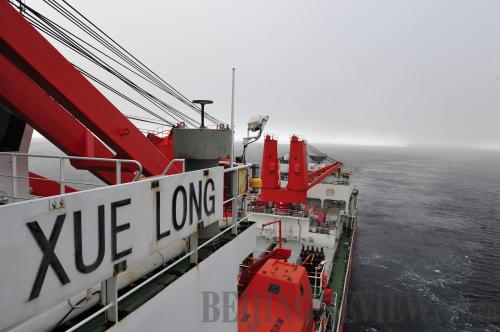|
 |
|
SUCCESSFUL ESCAPE: The Chinese research vessel and icebreaker Xuelong sails in open waters in the Antarctic on January 7 (ZHANG JIANSONG) |
The Antarctic Treaty was signed in 1959, declaring the Antarctic as a no man's land where scientific activity is not to be impeded while military activities are strictly prohibited. During the past five decades, all expedition teams in the area managed to maintain this agreement, offering a helping hand when others are in need is a necessity too.
"In the history of expeditions to the Antarctic, there is not one record of standing by when accidents occur. There is only a difference in how much one helps, but there are no refusals to lend a hand," Wang Zipan said.
According to statistics released by German Finance Online, major powers generally spend tens of millions of euros on expeditions to the Antarctic every year. The website said that China invested 42 million euros ($57 million) on scientific expedition projects in 2013 alone, making China one of the major players in the Antarctic. Xuelong's rescue mission also proved China's qualifications as a responsible power in the polar region.
Wang Xiaopeng, a researcher on marine studies with the Chinese Academy of Social Sciences pointed out that, since the Antarctic was declared a no man's land, competition around the area has never stopped. However, major powers have been helping each other in the area with scientific expeditions, establishing stations and salvaging ship wrecks in spite of public and hidden competition between them.
"Cooperation and mutual aid are traditions among explorers in the Antarctic. China received help from other countries in the past. The recent rescue was also carried in the spirit of cooperation and mutual aid," Wang Xiaopeng said.
Email us at: dingying@bjreview.com
About Xuelong
Built in Ukraine in 1993, Xuelong is an icebreaker that has been strengthened to give it a China Classification Society-rated Class B1 hull, allowing it to break ice up to 1.1 meters thick (including 0.2-meter-thick snow) at a sailing speed of 1.5 knots. Originally designed as an icebreaking cargo and supply ship, China bought it and refitted it into a polar research vessel.
The vessel is provided with advanced navigational, positioning and automatic piloting systems as well as two helicopter platforms, a hangar and the necessary equipment for helicopters. The ship has a total lab space of 200 square meters, which is shared between labs for marine physics, chemistry and biology, as well as meteorological and clean labs and a data processing center. The vessel is fitted with advanced equipment for researching and ocean surveying. Xuelong is currently under the control of the Polar Research Institute of China.
Source: Chinese Arctic and Antarctic Administration
Overall length: 167 meters
Molded breadth: 22.6 meters
Molded depth: 13.5 meters
Full draft: 9 meters
Full loaded displacement: 21,025 tons
Maximum speed: 18 knots
Cruising radius: 20,000 nautical miles
Main engine power: 13,200 kilowatts
Auxiliary engine power: 800 kilowatts (three on board)
Deadweight capacity: 10,225 tons | 